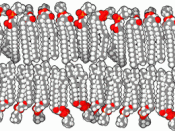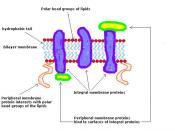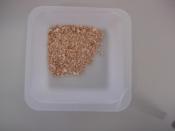Integral proteins are the main type of proteins in membrane proteins. They not only transport and receive nutrients and ions; they also carry out most membrane functions (Alberts et al. 2004). In integral proteins, there are usually two main types of proteins, transmembrane proteins and lipid anchored proteins. The former ones extend through the lipid bilayer. A hydrophobic domain of the protein lies in the interior of the bilayer and their hydrophilic regions are exposed to the outside on either side of the membrane (Medvedeva 2003). The latter ones are located entirely outside the bilayer, and are connected to the bilayer with one or more covalently attached lipid groups (Wikipedia 2005).
In-Gel Trypsin digestion experiment plays an important role in determining the two different types of integral proteins. Trypsin is a special digestive enzyme that can degrade proteins to amino acids (Aman and Wang 1987). Trypsin enzyme is a very big molecule and it is too large to go through the membrane (Aman and Wang 1987).
As a result, when the membrane is treated with trypsin, the proteins, which locate on the outside of the lipid bilayer, are digested by trypsin. However, the proteins that are located in the interior of the bilayer are not degraded. After the membranes been treated with trypsin, the digested membranes will be isolated from the membranes with detergent and separate by electrophoresis (Medvedeva 2003). Electrophoresis is the main technique for separating molecules. For protein extraction, the detergent SDS (sodium dodecyl sulfate) is used as the support medium, and all proteins on membranes become negatively charged by their attachment to the SDS anions (Medvedeva 2003). Usually the proteins will be separated on a polyacrylamide gel, and the whole procedure is called SDS-PAGE (Sodium Dodecyl Sulfate PolyAcrylamide Gel Electrophoresis) (Medvedeva 2003). At the beginning,


